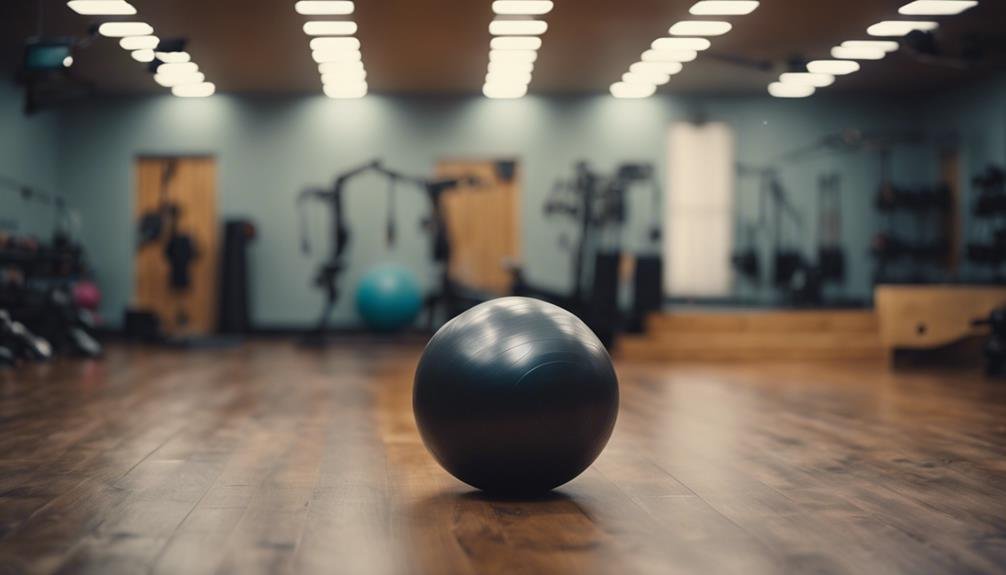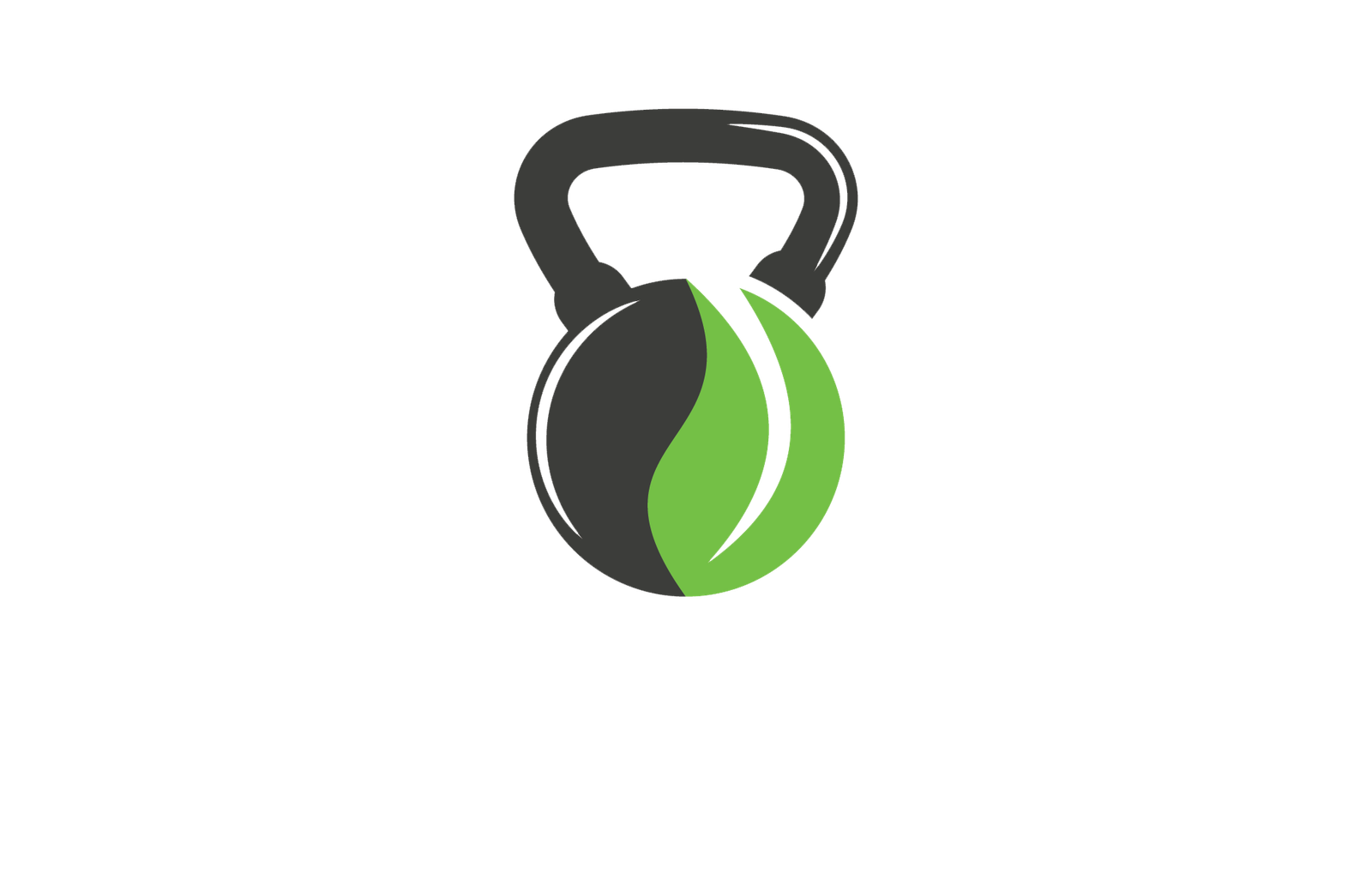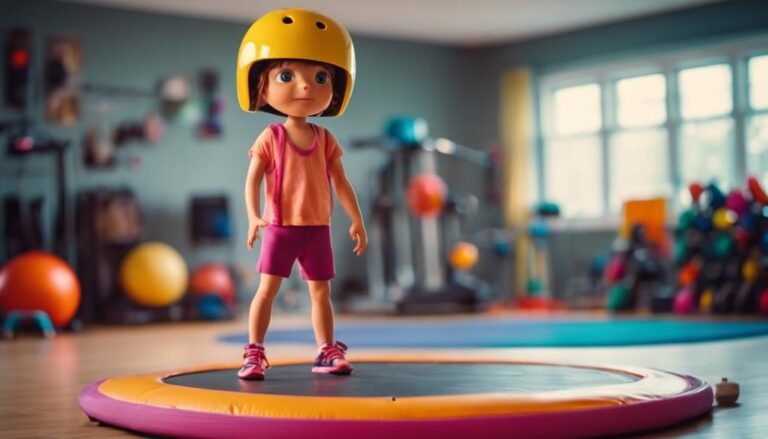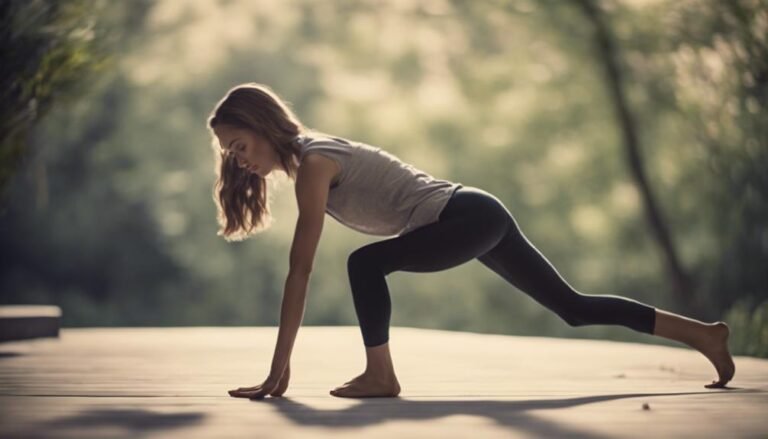Don't miss our holiday offer - 20% OFF!

Using Exercise Balls for Core and Stability Workouts
Optimize your core strength and stability with exercise balls, and discover the secret to improved posture, balance, and athletic performance.
We're incorporating exercise balls into our core and stability workouts because they offer a versatile, space-efficient, and fun way to strengthen our cores, improve our posture, and enhance our overall athletic performance. By using exercise balls, we can increase flexibility, balance, and coordination, while targeting our entire core, including abs, obliques, and lower back. We'll explore exercises that promote good posture, reduce injury risk, and improve overall strength. And as we dive deeper, we'll discover even more benefits and techniques to take our workouts to the next level.
Key Takeaways
- Exercise balls improve core strength and stability by engaging the transverse abdominis muscle and promoting good posture.
- Adjustable inflation allows for customizable firmness, ensuring optimal stability and workout experience.
- Core strengthening exercises on an exercise ball, such as planks and Russian twists, enhance athletic performance and reduce injury risk.
- Proper exercise ball technique involves engaging the core, maintaining a straight line from head to heels, and avoiding muscle imbalances.
- Regular exercise ball workouts improve overall flexibility, balance, and posture, leading to better functional strength and reduced muscle imbalances.
Benefits of Exercise Ball Training
Using an exercise ball in our workouts can be a game-changer, as it engages our core muscles more effectively than traditional exercises, leading to improved balance, posture, and overall athletic performance. By incorporating exercise balls into our fitness routine, we can experience a range of benefits that take our workouts to the next level. One of the most significant advantages is increased flexibility. Because exercise balls allow us to move our bodies in various planes of motion, we can improve our range of motion and reduce stiffness. Additionally, exercise balls promote space efficiency, which is perfect for those of us with limited workout space at home or in the gym. We can easily store them away when not in use, making them a convenient addition to our fitness arsenal. As we continue to challenge ourselves with exercise ball training, we'll notice improvements in our overall strength, stability, and coordination. By incorporating exercise balls into our workouts, we'll be on our way to a stronger, more balanced, and more flexible us!
Choosing the Right Exercise Ball
With numerous exercise ball options available, we need to weigh several factors to select the right one that suits our fitness goals and preferences. As we venture into the world of exercise balls, key is to examine the material selection. We'll want a ball that's durable, resistant to punctures, and easy to clean. Look for balls made from high-quality, thick rubber or PVC that can withstand intense workouts.
Another vital factor is ball inflation. We should opt for a ball that allows for adjustable inflation, allowing us to customize the firmness to our liking. Proper inflation is vital, as it affects the ball's stability and our overall workout experience. A ball that's too soft can compromise our form, while one that's too firm can be uncomfortable. By choosing the right exercise ball, we set ourselves up for success and a more effective workout. By taking the time to select the perfect ball, we can focus on what really matters – our fitness journey.
Core Strengthening Exercises to Try
We're ready to undertake a series of core-strengthening exercises that will challenge our stability, engage our muscles, and leave us feeling empowered and strong. As we begin these exercises, we'll focus on building core endurance, which is essential for everyday activities and overall fitness. One effective exercise is the pelvic tilt. To do this, we'll sit on the exercise ball with our feet flat on the floor, then tilt our pelvis upwards and backwards, repeating the motion for several reps. This exercise targets our transverse abdominis muscle, which is vital for core stability. Next, we'll try the plank on the exercise ball, which will engage our entire core, including our obliques and lower back muscles. By incorporating these exercises into our routine, we'll improve our core endurance, reduce our risk of injury, and enhance our overall athletic performance. With consistent practice, we'll be amazed at how strong and stable we can become.
Improving Posture With Exercise Balls
As we strengthen our core, we're also improving our posture, since a stable core provides a solid foundation for maintaining good posture, which is where exercise balls come in handy. By incorporating exercise balls into our workouts, we can improve our spinal alignment and develop better muscle memory. This, in turn, helps us maintain good posture even when we're not actively thinking about it.
Here are three ways exercise balls can help improve our posture:
- Increased awareness: Exercise balls force us to engage our core and maintain proper spinal alignment, making us more aware of our posture throughout the day.
- Strengthening core muscles: By targeting our core muscles, exercise balls help strengthen the muscles that support good posture.
- Improved flexibility: Exercise balls can help increase our flexibility, making it easier to maintain good posture even in challenging situations.
Balance and Stability Exercises
As we focus on balance and stability exercises, we're excited to explore the benefits of single-leg balance drills and dynamic movements on the exercise ball. These exercises will challenge our core strength and stability, helping us improve our overall balance and coordination. By incorporating these exercises into our routine, we can expect to see significant improvements in our overall fitness and athletic performance.
Single-Leg Balance Drills
By incorporating single-leg balance drills into our exercise routine, we can substantially improve our overall balance and stability, while also strengthening our core and enhancing our athletic performance.
To get started, we need to focus on proper foot positioning and ankle mobility. This will help us maintain balance and prevent injuries. Here are three key tips to keep in mind:
- Start small: Begin with shorter intervals and gradually increase the duration as our balance improves.
- Focus on ankle mobility: Make sure our ankles are flexible and able to move freely, allowing us to make adjustments as needed.
- Keep our core engaged: Engage our core muscles to maintain stability and prevent our bodies from swaying.
Dynamic Movements
We're ready to take our balance and stability training to the next level with dynamic movements that challenge our core and push our limits. Now that we've mastered single-leg balance drills, it's time to incorporate functional training exercises that mimic real-life movement patterns. Dynamic movements on the exercise ball will have us moving in multiple planes of motion, engaging our core and improving our overall stability.
We'll start with lateral walks, moving our feet from side to side while maintaining balance on the ball. Next, we'll try circular movements, rotating our torso while keeping our lower body stable. These exercises will challenge our ability to stabilize and control our movements, further engaging our core muscles. As we progress, we can increase the difficulty by adding arm movements, leg lifts, or even resistance bands to our dynamic movements. By incorporating these exercises into our routine, we'll improve our overall functional strength and stability, preparing us for the demands of everyday life. With dynamic movements, we're not just working out – we're training for life.
Engaging Your Core With Planks
As we move on to engaging our core with planks, we'll focus on getting it right from the start. We'll cover the importance of proper plank positioning, ensuring we're targeting the correct muscles and avoiding common mistakes. By mastering the basics, we'll be able to effectively engage our core muscles and see real results from our exercise ball workouts.
Proper Plank Positioning
When executing a plank, we start by assuming a push-up position with our hands shoulder-width apart and our arms straight, engaging our core muscles from the very beginning. This foundational position sets the stage for a successful plank, but it's only the starting point. To truly benefit from this exercise, we need to focus on proper plank positioning.
As we settle into our plank, we need to cultivate body awareness, paying attention to our posture, alignment, and muscle engagement. This awareness helps us identify and correct muscle imbalance, which can lead to poor form and injury. By honing in on our body's positioning, we can optimize our plank and reap the rewards of a stronger, more stable core.
Here are a few key checkpoints to maintain proper plank positioning:
- Shoulders down and away: Avoid scrunching our shoulders up towards our ears, instead, focus on relaxing them down and away from our ears.
- Engaged core: Draw our belly button towards our spine, engaging our transverse abdominis muscle.
- Straight line from head to heels: Maintain a straight line from the crown of our head to our heels, engaging our entire core and promoting good posture.
Engaging Core Muscles
By cultivating proper plank positioning, we've set the stage to effectively engage our core muscles, and now it's time to tap into their full potential. As we hold our plank, we need to focus on engaging our core muscles by drawing our belly buttons towards our spines. This helps to activate our transverse abdominis, the deepest abdominal muscle that wraps around our spine and pelvis. By doing so, we're increasing our core awareness, which is crucial for maintaining good posture, preventing muscle imbalance, and reducing our risk of injury.
As we engage our core, we should feel a subtle contraction in our midsection. We must avoid holding our breath or tensing our shoulders, as this can create muscle imbalance and undermine the effectiveness of the exercise. Instead, we should focus on maintaining a steady, relaxed breathing pattern, allowing our core muscles to do the heavy lifting. By mastering this technique, we'll be able to tap into the full potential of our core muscles, leading to improved overall strength, stability, and athletic performance.
Exercise Ball Workout Routines
We'll start with a dynamic warm-up routine that gets our hearts pumping and our cores engaged, using a combination of exercises that target our entire core, including our abs, obliques, and lower back. This warm-up is essential to prepare our muscles for the upcoming workout and prevent injuries. Remember, ball safety is key, so make sure to choose an exercise ball that's the right size for you and to always listen to your body.
- Plank on the Ball: Strengthens your core and improves posture.
- Russian twists: Targets your obliques and boosts rotational power.
- Ball crunches: Engages your abs and enhances overall core stability.
These exercises will not only challenge your core but also make your workout fun and engaging. By incorporating these exercises into your routine, you'll experience a more effective and enjoyable workout.
Targeting Different Muscle Groups
Now that we've got our hearts pumping and cores engaged, let's focus on targeting different muscle groups to achieve a more balanced workout. Exercise balls are perfect for this, as they allow us to work multiple muscle groups simultaneously, improving overall functional strength and reducing muscle imbalances.
| Muscle Group | Exercise Ball Exercises |
|---|---|
| Chest and Triceps | Incline push-ups, tricep dips |
| Back and Biceps | Row exercises, bicep curls |
| Legs and Glutes | Wall squats, leg raises |
| Shoulders and Core | Plank variations, shoulder rotations |
Safety Precautions and Tips
When working out with exercise balls, we must prioritize our safety and well-being by following essential precautions to minimize the risk of injury and maximize our exercise effectiveness.
To guarantee a safe and effective workout, we need to focus on proper ball handling and exercise etiquette. Here are some tips to keep in mind:
- Start slow: Begin with lighter exercises and gradually increase the intensity as we build strength and endurance.
- Inspect the ball: Before each use, inspect the ball for any signs of wear and tear, and inflate it to the recommended pressure.
- Create space: Make certain we have enough space to move around comfortably, avoiding any obstacles or tripping hazards.
Incorporating Exercise Balls Into Daily Life
Incorporating exercise balls into daily life can be as simple as swapping out our traditional office chair for an exercise ball, which can help improve our posture and engage our core muscles even when we're not actively working out. By doing so, we can experience the benefits of exercise balls beyond our regular workout routine. For instance, we can use exercise balls for desk stretching, taking short breaks to stretch our arms, shoulders, and back while sitting on the ball. This can help reduce the risk of developing musculoskeletal disorders and improve our overall office fitness.
Here are some ways to incorporate exercise balls into our daily life:
| Activity | Benefits | Frequency |
|---|---|---|
| Sitting on an exercise ball at work | Improved posture, engaged core | Daily |
| Taking desk stretching breaks | Reduced muscle tension, improved flexibility | 2-3 times a day |
| Using an exercise ball for lounging | Improved balance, strengthened core | 30 minutes, 2-3 times a week |
| Playing with an exercise ball with kids | Improved coordination, bonding time | 1-2 hours, weekly |
Frequently Asked Questions
Can Exercise Balls Be Used for Rehabilitation and Physical Therapy?
"We've seen exercise balls effectively aid post-injury rehab and surgical recovery by improving flexibility, strength, and balance in a low-impact, controlled environment, allowing us to gradually progress towards full recovery."
Do Exercise Balls Work for People With Back Problems or Injuries?
"We've seen exercise balls provide excellent back support, offering pain relief for people with back problems or injuries by strengthening core muscles and improving posture, allowing for a smoother recovery."
Can Children Use Exercise Balls for Fun and Fitness?
"Did you know 1 in 5 kids is obese in the US? We think exercise balls can be a game-changer for kids' play, making fun fitness a blast! Playtime exercises, fitness games, and young athletes can benefit from these balls, helping combat childhood obesity."
Are Exercise Balls Beneficial for Seniors and Elderly Individuals?
We believe exercise balls can greatly benefit seniors, as they help with fall prevention by improving balance and stability, and can even boost elderly motivation to stay active and engaged in fitness activities.
Can Exercise Balls Be Used for Yoga and Pilates Exercises?
We incorporate exercise balls into our yoga and Pilates routines to enhance flexibility and strength, focusing on Ball Flow movements that engage our Core Focus, allowing for a more dynamic and challenging workout experience.
Conclusion
As we wrap up our exploration of exercise balls, we're reminded that incorporating them into our daily routine can have a significant impact. In fact, a study by the American Council on Exercise found that exercise ball training can increase core strength by up to 70%! With the benefits of improved posture, balance, and overall stability, it's no wonder exercise balls have become a staple in many fitness routines. By incorporating exercise balls into our daily lives, we can take our fitness journeys to the next level.



